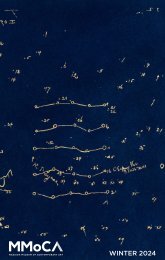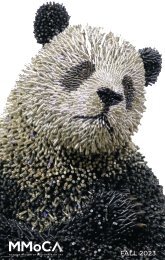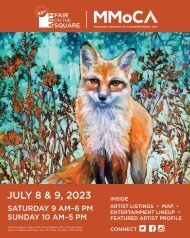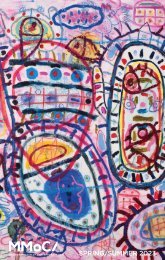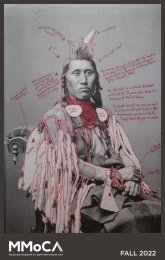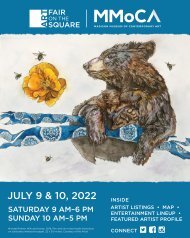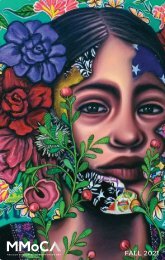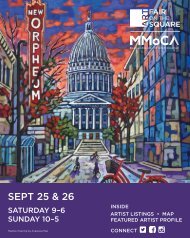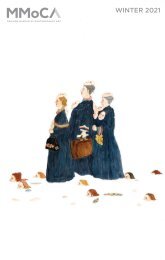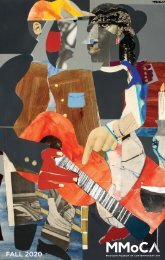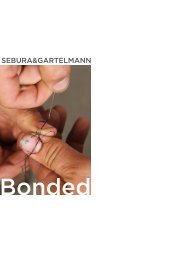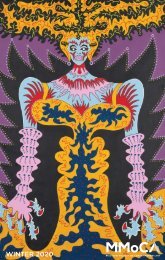Wisconsin Triennial Brochure 2019
Exhibition brochure for the 2019 Wisconsin Triennial
Exhibition brochure for the 2019 Wisconsin Triennial
You also want an ePaper? Increase the reach of your titles
YUMPU automatically turns print PDFs into web optimized ePapers that Google loves.
DIANE LEVESQUE KENOSHA<br />
Dancing Bear and Savoyard, from The Penny Dreadful Project, 2018 •<br />
Acrylic on canvas, 48 x 40 inches • Courtesy of the artist<br />
Diane Levesque’s ongoing series of paintings and drawings, The Penny Dreadful<br />
Project, reinterprets themes depicted in Staffordshire figurines produced<br />
between 1810 and 1835. These popular collectibles portrayed idealized<br />
pastimes as well as disturbing and often violent contemporaneous events<br />
from infamous murders to public hangings. Despite this, or perhaps because<br />
of it, the figurines were acquired as decorative household items. These themes<br />
also corresponded to what could be read in “penny dreadfuls,” popular serial<br />
literature from the same era with sensational storylines. With bold color and<br />
energetic brushstrokes, Levesque heightens the implied violence and sexuality<br />
of the stories, transforming the decorative motifs of the Victorian era into social<br />
commentary that is unsettling yet alluring.<br />
GINA LITHERLAND CEDARBURG<br />
Yggdrasil, 2018 • Oil on panel, 20 x 40 inches • Courtesy of the artist and<br />
Corbett vs. Dempsey, Chicago<br />
Gina Litherland’s immaculately rendered paintings reference the artistic<br />
tradition of magic realism and the narrative plotlines found in folktales.<br />
Litherland creates her own mythologies in her wood panel paintings, twisting<br />
familiar iconographies and storylines into new realms of the uncanny where<br />
young girls befriend tigers and join packs of dogs howling at the moon. In her<br />
painting Yggdrasil, Litherland illustrates the Tree of Life from Norse Mythology,<br />
the three “Norns” (female beings who control the fate of both gods and<br />
humans) appear as girls eerily floating beneath the tree, lit from below, toying<br />
with their environment. Litherland imbues her mystical worlds with tales of<br />
female empowerment, making them places where young girls and women<br />
have immense power and magic over their incongruous surroundings.<br />
DAKOTA MACE MADISON<br />
Na’ashch’áá’ I, 2018 • Cyanotype/digital media on paper, 24 x 24 inches •<br />
Courtesy of the artist<br />
Dakota Mace is a Diné (Navajo) artist who reinterprets the symbolic abstractions<br />
of Diné creation stories, cosmologies, and social structures. Mace uses a<br />
combination of traditional and nontraditional materials, taking Diné visual culture<br />
and design out of the realm of weaving and into printmaking and photography.<br />
Subverting expectations of Diné designs as utilitarian or decorative objects, Mace<br />
transforms and preserves these traditions while bringing them firmly into the<br />
fine art realm, engaging in an act of cultural reclamation. The abstracted symbol<br />
of Na’ashjéii Asdzáá (Spider Woman) is the most prevalent motif seen in Mace’s<br />
designs and one of the most important deities in the Diné Bahané (creation story)<br />
as she was the first to weave her web of the universe while spreading Hózhó<br />
Náhásdlíí’ (beauty way) teachings of balance within the mind, body, and soul.<br />
Mace affirms the importance of the cultural signifiers while embracing her belief<br />
of hajisí dígíí dahiistłó biihji nilłx (we weave what we see).<br />
FRANCISCO MORA FOX POINT<br />
Travesía en la Panza de un Burro (Voyage in a Donkey’s Belly), 2018 •<br />
Graphite on paper, 12 x 16 inches • Courtesy of the artist<br />
Francisco Mora’s drawings reveal the imaginary world of his dreams. Playing with<br />
scale, he transforms humans into animals and back again, sending his fantastical<br />
characters on journeys through a mysterious jungle. Born and raised in Mexico City,<br />
Mora draws on the visual traditions of Mexican surrealism in which Mexican artists<br />
merged their own histories and folklore with the ideas that had defined surrealism<br />
throughout Europe. The resulting works of art transformed and expanded the<br />
movement through new stylistic innovations and cultural references. Mora’s body<br />
of work catalogues his imagination, in which a giant child, a wizard, a woman<br />
traveling inside of a donkey’s stomach, a fish-man, and a bird-man all intersect<br />
in a visionary, hand-penciled world.<br />
5






